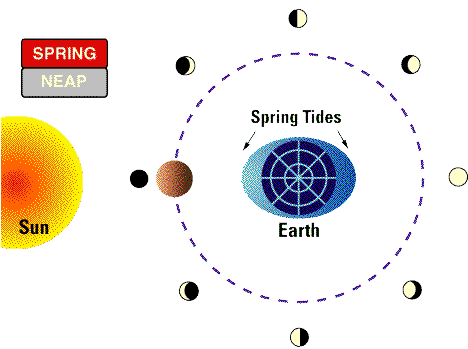Introduction and Principles
This simplified animation opposite gives an indication of how the Moon goes
around the Earth and how the tides are affected by gravity. The pull from the gravity of the Moon pulls
both the earth and the sea towards
it. This is what causes the tides. The Sun also has a gravitational pull
which either increases the pull on the sea or reduces it, depending on the position
of the sun relative to the Moon.
If the Sun and Moon are in line, whether or not they are on the same side or opposite
sides of the Earth, the effect causes higher tides. These are called spring
tides.

When the Sun and Moon are at 90° to each other the tides are smaller because
the pulls are opposed. These are called neap tides.
There are two tides at any given time one on each side of the Earth.
For those wishing for an explanation on why there are two tides per day, one
of which is on the opposite side of the Earth to the Moon, here it is:
As the Moon circles the Earth it not only pulls the sea towards it but the
land and the Earth itself. It also pulls the centre of gravity of the Earth
towards it.
This results in a slightly reduced gravity on the opposite side of the Earth
allowing centrifugal force to push the sea outwards causing a second tide. You could imagine it almost as a wobble!
